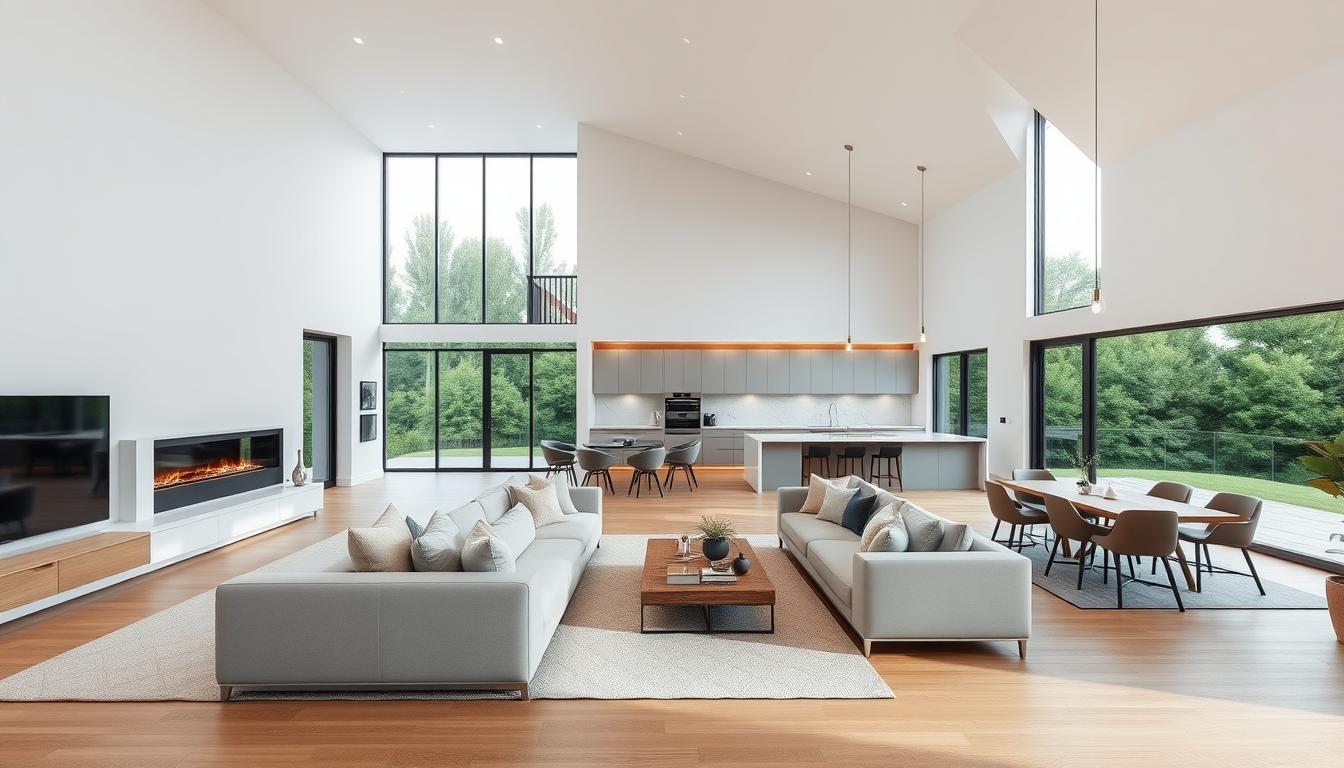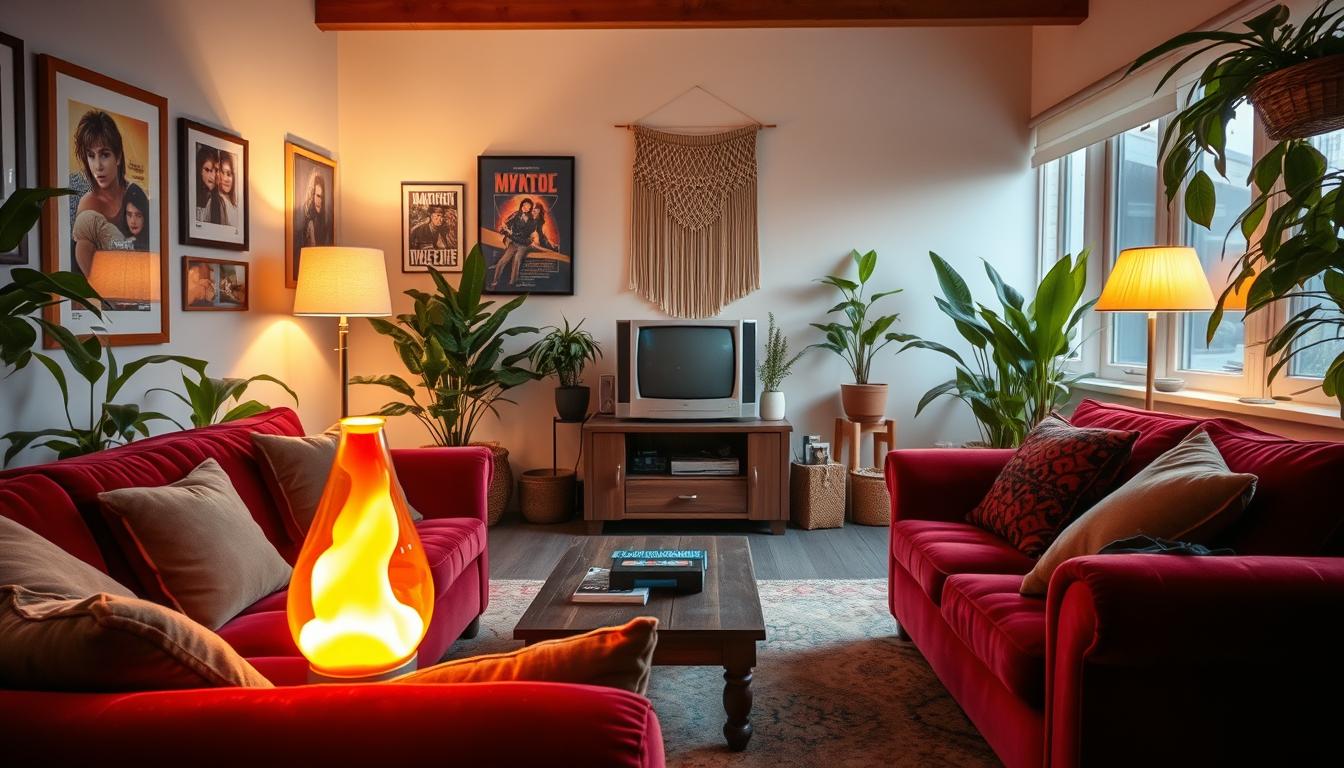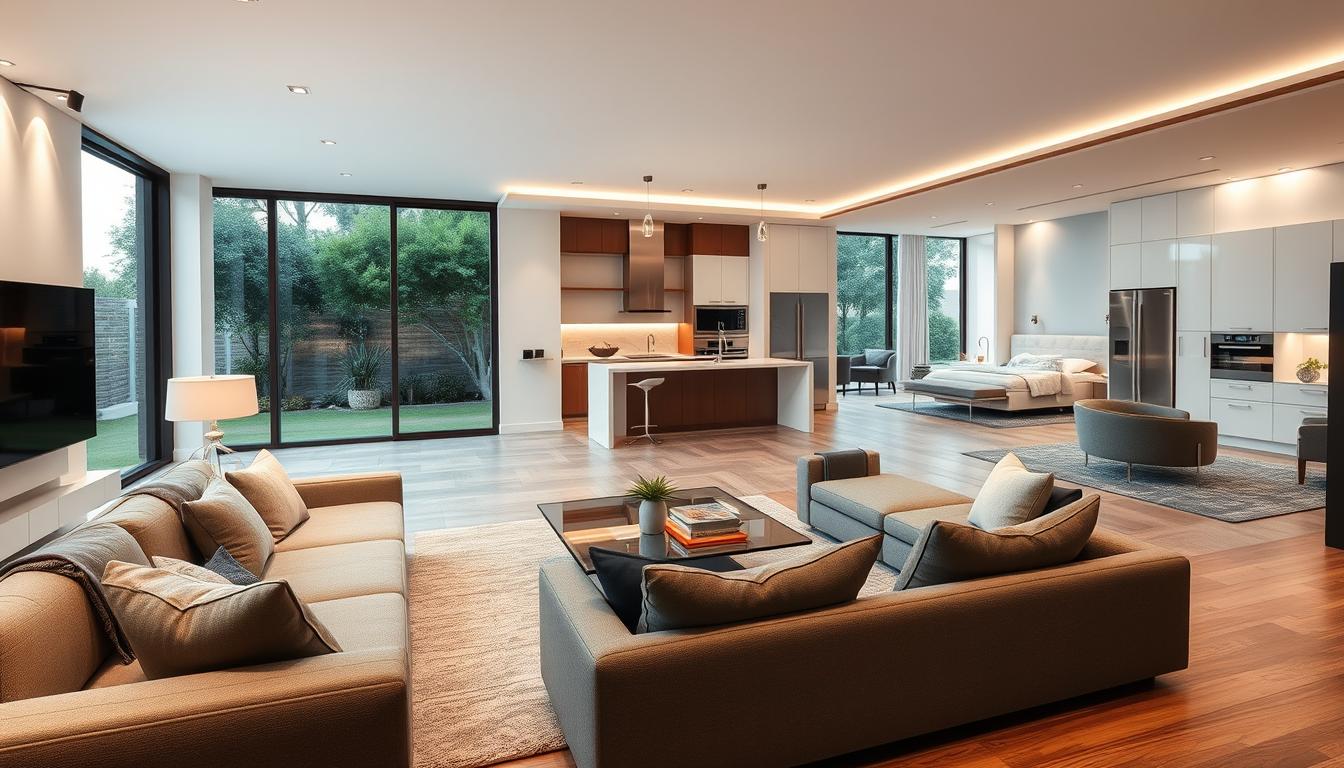Did you know a good interior design can boost a home’s value by up to 10%? With more new construction projects, people are focusing on making homes both beautiful and practical.
We’ll cover the basics of making your new build home look great with interior design tips. Whether you’re a homeowner or a builder, learning about new construction interior design can make your project stand out.
Key Takeaways
- Understanding the basics of interior design for new builds
- Key considerations for creating a functional living space
- Popular design styles for new construction homes
- Tips for enhancing your new build home with expert interior design
- Common mistakes to avoid in new construction interior design
Understanding the Basics of Interior Design
To make your home truly yours, learning about modern interior design is key. This knowledge helps you make smart choices when designing your new home.
Interior design mixes beauty, function, and how people feel in a space. It’s more than just decorating. It’s about making a space that improves your life.
What is Interior Design?
Interior design is both an art and science. It’s about understanding people to create spaces that are both beautiful and useful. It’s about knowing what people need and how spaces affect them.
A good interior design can change how you feel and work. It balances looks and use, making spaces that are nice to look at and practical.
Importance of Interior Design in New Homes
In new homes, contemporary home design is vital. It makes your home more livable and valuable. A well-designed interior can also attract buyers if you decide to sell.
A well-designed home can also make your daily life better. It creates spaces that are efficient, comfortable, and stress-free. It’s about finding harmony between your space and you.
Learning about interior design helps homeowners make choices that fit their needs and style. This ensures your space is both functional and personal.
Key Considerations for New Build Homes
New build homes are a blank canvas for interior designers. They must consider several key points. Understanding the home’s unique features is crucial for residential interior design.
Analyzing Space and Layout
Examining the space and layout is a key step. We must think about the home’s flow, making sure it’s both functional and comfy. This means looking at room sizes, door and window spots, and architectural details that might affect design.
Assessing Natural Light and Orientation
Looking at natural light and the home’s orientation is also important. The light a room gets can change its feel and use. We consider the home’s layout and how it affects light, guiding decisions on windows, lights, and colors.
Choosing a Design Style
Picking a design style that fits the homeowner’s taste is key. The style should match their personality and lifestyle. We work with homeowners to find the right residential interior design that meets their needs and dreams.
By carefully looking at the space, light, and style, we create a beautiful and useful living area. This enhances the quality of life for everyone.
Popular Interior Design Styles for New Builds
When it comes to interior decorating for new homes, the possibilities are endless. New build homes offer a blank canvas. This lets homeowners explore various interior design styles. They can create a space that reflects their personality and meets their needs.
Let’s explore some of the most popular interior design styles for new builds. We’ll look at their unique characteristics and what makes them appealing.
Modern Minimalism
Modern Minimalism is all about simplicity, clean lines, and a limited color palette. It’s perfect for those who value functionality and ease of maintenance. Key elements include:
- Minimal ornamentation
- Neutral color schemes
- Open floor plans
- Abundant natural light
Modern Minimalism is not just about looks. It’s also about creating a calm and serene home.
Traditional Elegance
For a classic look, Traditional Elegance is a timeless choice. This style is marked by:
- Rich, warm color schemes
- Ornate details and patterns
- Classic furniture pieces
- Luxurious fabrics and textures
Traditional Elegance creates a cozy, inviting atmosphere. It’s perfect for families and those who enjoy entertaining.
Industrial Chic
Industrial Chic celebrates the raw, urban aesthetic of industrial spaces. Characteristics include:
- Exposed brick and ductwork
- Metal accents and reclaimed wood
- Edgy, modern lighting fixtures
- A predominantly neutral color palette with pops of bold color
This style is ideal for those who appreciate the urban, edgy look and feel.
Eclectic Combinations
For the more adventurous, Eclectic Combinations offer the freedom to mix and match different styles. This style is all about:
- Blending different patterns, textures, and colors
- Incorporating vintage and modern pieces
- Experimenting with bold, contrasting colors
- Adding personal, meaningful items and decor
Eclectic Combinations allow homeowners to express their individuality and creativity.
To better understand the differences between these styles, let’s compare some of their key features in the following table:
| Style | Color Scheme | Furniture | Lighting |
|---|---|---|---|
| Modern Minimalism | Neutral | Simple, functional | Bright, airy |
| Traditional Elegance | Rich, warm | Classic, ornate | Warm, soft |
| Industrial Chic | Neutral with bold accents | Metal, reclaimed wood | Edgy, modern |
| Eclectic Combinations | Varied, bold | Mixed, vintage, and modern | Diverse, statement pieces |
Selecting the Right Color Palette
A good color palette is key to great interior design. It sets the mood and feel of your new home. Think about how colors affect your space’s look and use.
Psychology of Colors
Colors deeply affect our feelings and actions. For example, blue tones bring calm and peace, perfect for bedrooms. Warm colors like orange and red boost energy, great for living rooms.
Knowing how colors work can guide your choices. Pick colors that match each room’s purpose in your home.
Trending Color Schemes
Keeping up with color trends can spark your design. Neutral tones with bold touches are in, offering a blank canvas for your style. Monochromatic schemes are also popular, for their sleek and unified look.
When using trendy colors, think about your style and your home’s design. This ensures a good fit.
How to Match Colors
Getting colors to work together is vital. The 60-30-10 rule is helpful: 60% main color, 30% secondary, and 10% accent. This mix adds interest without being too much.
Another way is to pick colors next to each other on the color wheel. This creates a smooth flow between colors.
By understanding color psychology, current trends, and matching techniques, you can pick a palette that boosts your home’s look. It should also show off your personal taste. Home design services can offer expert advice on choosing the right colors for your new home.
Choosing Furniture and Décor
Choosing the right furniture and décor is key for new build homes. It makes your home look good and feel comfortable. The right pieces can make your home beautiful and practical.
Essential Furniture Pieces
Start by getting the essential furniture for your new home. This includes:
- A comfy sofa and armchairs for the living room
- A strong dining table and chairs for meals
- A top-notch bed and mattress for your bedroom
These items are the base of your home’s look and should be both stylish and useful.
Accessories to Enhance Aesthetics
After getting the basic furniture, add accessories to make your home look better. You can use:
- Artwork and prints for a personal touch
- Rugs and mats to mark different areas
- Plants and flowers for a natural feel
Accessories can really change how your home feels. They make it more welcoming and unique.
“The right accessories can make a house feel like a home by adding character and warmth.” –
Balancing Functionality and Style
Finding the right balance between function and style is a big challenge. You need furniture that looks good but also works well.
| Furniture Piece | Functionality | Style |
|---|---|---|
| Sofa | Comfortable seating | Modern design |
| Dining Table | Space for dining | Elegant finish |
By thinking about both function and style, you can make a space that’s both beautiful and practical.
Sustainable Interior Design Choices
Choosing sustainable design for your new home is good for the planet and makes your space better. As we look into custom home interiors, thinking about our choices is key.
Eco-Friendly Materials
Using eco-friendly materials is a big part of green design. These materials are made and sourced in ways that don’t hurt the environment. Some examples are:
- Reclaimed or recycled wood
- Bamboo and other fast-growing plants
- Low-VOC (Volatile Organic Compound) paints
- Sustainably sourced stone and marble
Choosing these materials helps make our homes less harmful to the planet.
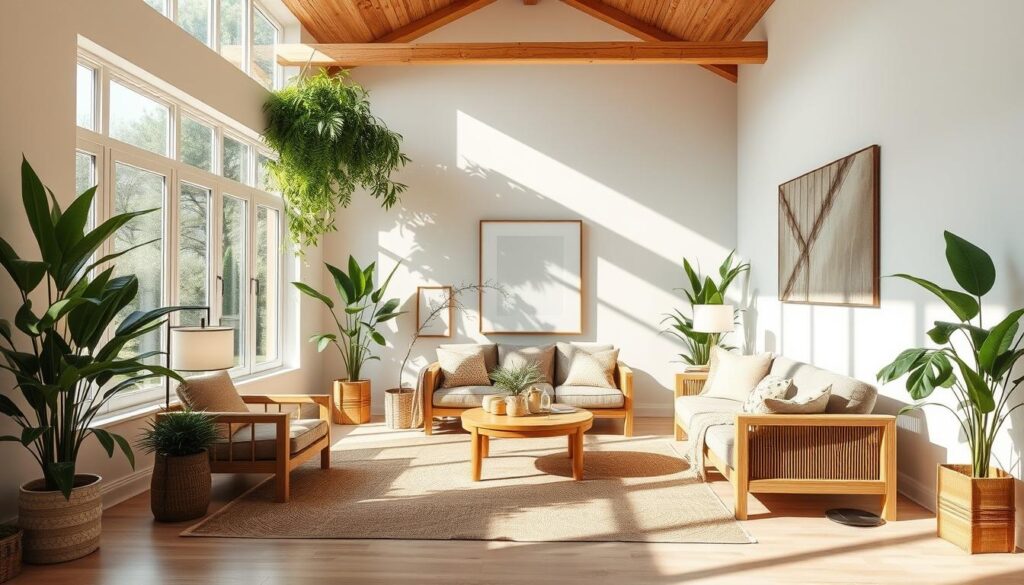
Energy-Efficient Solutions
Being energy-efficient is also important in green design. It means picking things that use less energy but still work well. Some examples are:
- LED lighting, which uses much less energy than old lights
- Energy-saving appliances and HVAC systems
- Smart home tech that helps save energy
These choices help the planet and can also save money on bills over time.
Incorporating Biophilic Design
Biophilic design brings nature into our homes. This can include:
- Using lots of natural light
- Adding plants and green walls
- Choosing natural materials and textures
- Creating views or connections to the outdoors
Biophilic design can make us feel better, work better, and live better.
| Design Element | Eco-Friendly Option | Benefit |
|---|---|---|
| Flooring | Bamboo or reclaimed wood | Reduces demand on virgin timber |
| Lighting | LED bulbs | Significantly reduces energy consumption |
| Paints | Low-VOC or zero-VOC paints | Improves indoor air quality |
By picking these green design choices, we can make homes that are not just pretty but also good for the planet. As we keep exploring custom home interiors, it’s clear that going green is key for the future.
Working with Professional Interior Designers
Professional interior designers can help you create your dream home. They bring a lot of knowledge to the table. Working with them can make your project better by adding their expertise and experience.
Expertise and Benefits
There are many benefits to hiring an expert interior designer. They have access to a vast network of suppliers and contractors. They also have expert knowledge of spatial planning and insight into the latest design trends. They can help you avoid mistakes and make sure your design looks good and works well.
Some key advantages of working with a professional include:
- Personalized design solutions tailored to your lifestyle and preferences
- Expert guidance on selecting materials, finishes, and furniture
- Effective project management to ensure timely completion
Selecting the Right Designer
Finding the right interior designer for your new build home is important. Here are some things to consider:
| Criteria | Description | Importance Level |
|---|---|---|
| Experience | Look for designers with a proven track record in new build homes | High |
| Portfolio | Review their portfolio to ensure their style aligns with your vision | High |
| Client Reviews | Check for positive feedback from previous clients | Medium |
The Design Process
After choosing an interior designer, you should know what to expect. The process usually includes:
- Initial consultation to discuss your goals and preferences
- Space planning and design concept development
- Selection of materials, finishes, and furniture
- Implementation and project management
Understanding the benefits of hiring a professional, choosing the right designer, and knowing the design process can lead to a successful project. This way, you can make your new build home interior design project a success.
DIY Interior Design Tips for New Builds
Turning your new home into a personalized space is easy with DIY interior design. You can create a unique look without spending a lot. Just use your creativity and some basic tools.
Budget-Friendly Projects
DIY interior design is great because it’s affordable. Here are some projects to start with:
- Painting walls and ceilings for a fresh look
- Making decorative wall art with canvas, paint, and wood
- Renovating old furniture to look modern
- Adding plants to improve your home’s look and air
These projects save money and let you add your personal touch.
Tools and Resources for DIYers
To do your DIY projects well, you need the right tools and resources. Here are some essentials:
| Tool/Resource | Description | Usefulness |
|---|---|---|
| Paintbrushes and rollers | For painting walls and ceilings | High |
| Power drill | For drilling holes and driving screws | High |
| Tape measure | For measuring spaces and materials | Medium |
| Online tutorials | For guidance on various DIY projects | High |
Having the right tools and resources is key to a successful DIY project.
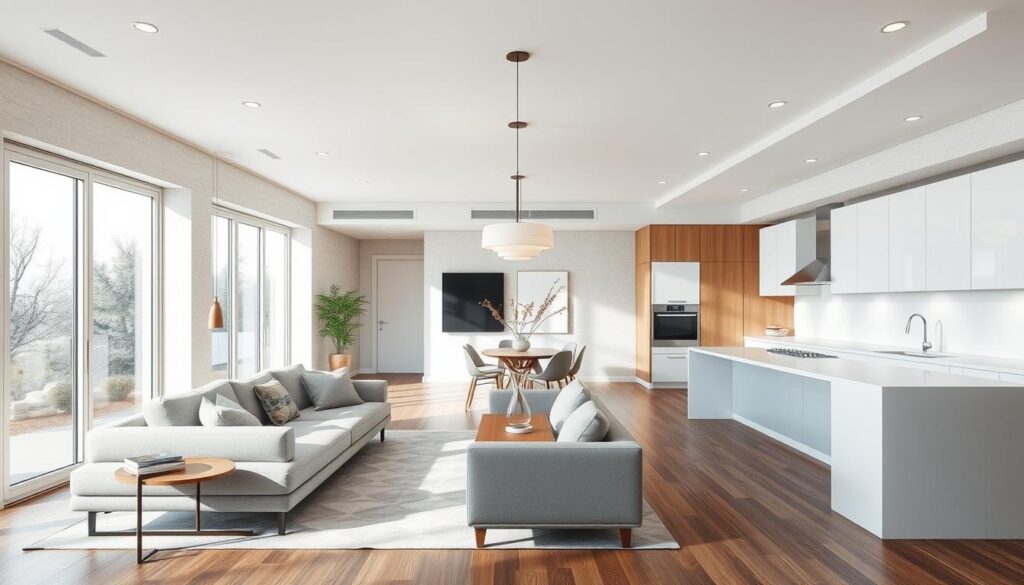
Common Mistakes to Avoid
DIY interior design can be rewarding but watch out for common mistakes:
- Not measuring spaces correctly before buying materials
- Choosing the wrong paint color or finish
- Not following safety guidelines when using power tools
- Underestimating the time and effort required for a project
Knowing these mistakes helps you plan better and avoid costly errors.
DIY interior design makes your new home unique and adds value. With careful planning, the right tools, and creativity, you can achieve a modern interior design you’ll love for years.
Final Touches: Bringing It All Together
As we wrap up our guide to interior design for new homes, the final touches are key. They make a space come alive. A cohesive and inviting atmosphere needs detail and a grasp of modern design.
Creating a Unified Space
To unite a space, pick a few main design elements. Use them everywhere. This could be a consistent color scheme, matching furniture, or a common texture. It creates a smooth flow and harmony, linking everything together.
Adding Personal Touches
Adding personal touches makes a house truly feel like home. Include unique decor, family treasures, or special artwork. It gives your space character and personality.
Maintenance and Care
To keep your new home looking great, think about maintenance and care. Regular cleaning, dusting, and polishing help keep your design looking sharp. Following these tips, we can enjoy our beautifully designed homes for many years.

